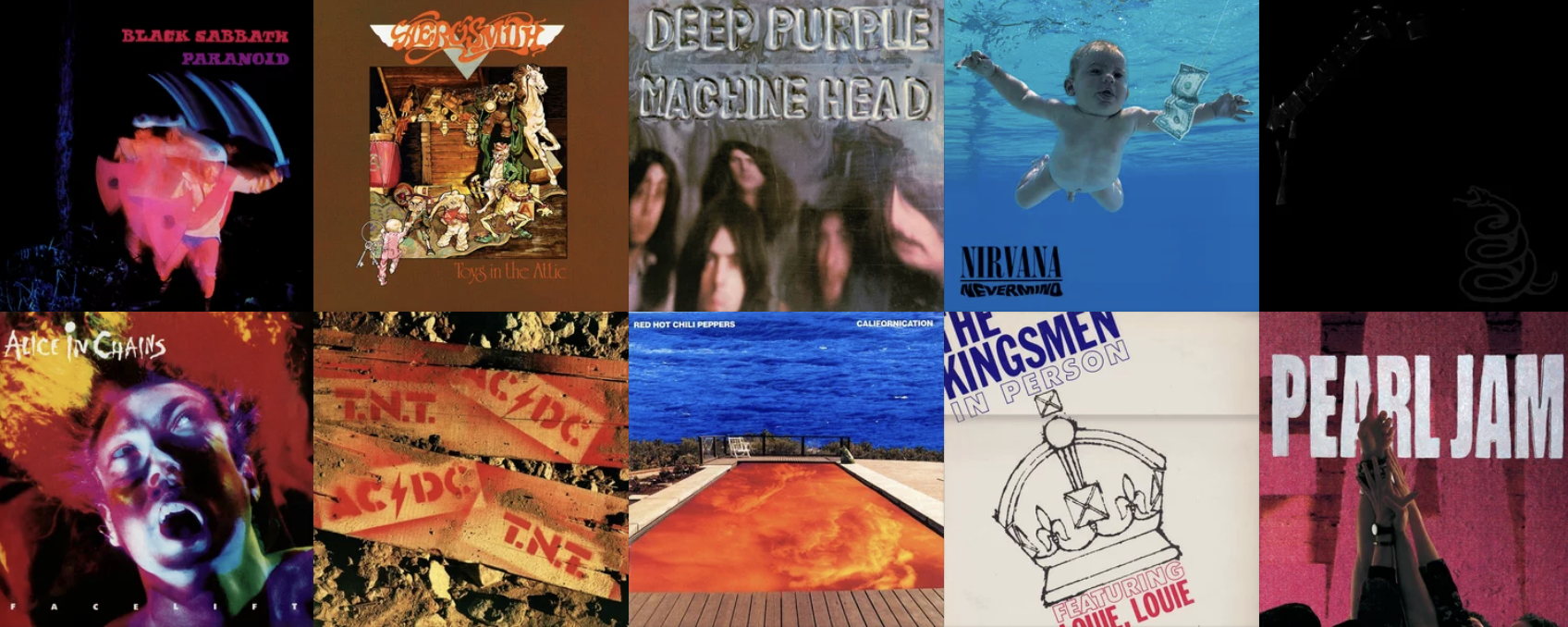
Why Learn These Classic Guitar Riffs?
These 10 riffs represent some of the most recognizable guitar parts in rock history. Learning them will not only make you sound great but also teach you fundamental techniques that apply to countless other songs.
Interactive Guitar Riffs Tab Player
Use the dropdown below to select and practice each of the 10 beginner guitar riffs. The player includes standard notation and guitar tablature. All riffs use all downstrokes except for Come As You Are and Walk This Way (they include upstrokes). Come As You Are and Enter Sandman both start at the end of a bar - press the metronome button to hear this timing. Remember that the top staff (the one with musical symbols, not the tab with fret numbers) includes the fingers on the left hand for you to use.
How to Read This Tab
- Standard Notation: The top staff shows traditional music notation for rhythm and pitch.
- Tablature (TAB): The lower staff shows fret numbers for each string—play the indicated fret on the matching string.
- Picking Symbols: ⊓ = Downstroke, ∨ = Upstroke.
- Brackets ( ): Numbers in brackets are notes held from the previous bar.
- Slurs: Curved lines between notes indicate hammer-ons or pull-offs (pick the first note, then use your left hand for the next note without picking).
- Slides: A diagonal line or "sl." between notes means slide your finger from the first note to the next without lifting.
- Fingering: Numbers above the top staff suggest which left-hand finger to use (1 = index, 2 = middle, 3 = ring, 4 = pinky).
Complete Guide to 10 Easy Guitar Riffs
Each riff below is carefully selected to progressively build your guitar skills, from absolute beginner to more challenging techniques.
1. Smoke On The Water - Deep Purple
From the album "Machine Head" (1972) - The quintessential beginner riff. Uses the same two strings with easy fingering.
2. TNT - AC/DC
From the album "T.N.T." (1975) - A driving rock riff that introduces string bending and moving between different string sets.
3. Otherside - Red Hot Chili Peppers
From the album "Californication" (1999) - A clean, melodic riff that's slightly faster with more movement around the fretboard.
4. Come As You Are - Nirvana
From the album "Nevermind" (1991) - Features more movement back and forth between strings with a distinctive grunge sound.
5. Jeremy - Pearl Jam
From the album "Ten" (1991) - Introduces hammer-ons and requires faster speed with melodic playing.
6. Man In The Box - Alice In Chains
From the album "Facelift" (1990) - Introduces dead notes and string damping techniques.
7. Louie Louie - The Kingsmen
A classic three-chord progression (1963) that requires moving power chords on different string sets.
8. Walk This Way - Aerosmith
From the album "Toys in the Attic" (1975) - Requires alternate picking and is quite fast.
9. Iron Man - Black Sabbath
From the album "Paranoid" (1970) - Requires sliding power chords and more movement across the fretboard.
10. Enter Sandman - Metallica
From "The Black Album" (1991) - Requires palm muting, more difficult timing, and covers a wider fret range.
Note on Difficulty Order: These riffs are arranged in order of increasing difficulty, starting with the most accessible techniques and progressing to more challenging elements. However, difficulty is subjective and varies from player to player. Some may find certain riffs easier or harder based on their individual strengths, hand size, or previous experience. Don't be discouraged if you struggle with a "lower" number riff - focus on what feels comfortable for you and gradually work your way up at your own pace.
How to Practice These Guitar Riffs Effectively
Essential Practice Tips
Start Slow
Begin at a comfortable tempo and gradually increase speed. Accuracy is more important than speed.
Use a Metronome
Practice with a steady beat to develop proper timing and rhythm.
Focus on Clean Notes
Ensure each note rings clearly without buzzing or muting adjacent strings.
Practice Daily
Short, consistent practice sessions are more effective than long, infrequent ones.
Common Techniques You'll Learn
- Power Chords - Foundation of rock music (5th and root notes)
- 1/4 Bends - Adds expression and blues feel
- Hammer-ons and Slides - Smooth note transitions
- Dead Notes/Muting - Rhythmic percussive effects
- Alternate Picking - Efficient picking technique
- Palm Muting - Creates tight, percussive sound
Next Steps in Your Guitar Journey
After Mastering These Riffs
Once you've learned these 10 classic riffs, you'll have a solid foundation in rock guitar playing. These songs use fundamental techniques that appear in thousands of other songs.
Recommended Next Steps:
- Learn complete songs, not just the main riffs
- Practice chord progressions and rhythm guitar
- Explore blues scales and lead guitar techniques
- Study more advanced rock and metal riffs
- Work on improvisation and creating your own riffs
Continue Your Learning Journey
Master Rhythm Guitar
Build on these riffs by learning essential strumming patterns that work with thousands of songs.
Learn Strumming Patterns →Develop Finger Technique
Strengthen your fingers and improve dexterity with targeted exercises for better guitar playing.
Practice Finger Exercises →Remember, consistent practice is key to improvement. These classic riffs will serve as building blocks for your entire guitar-playing journey. Each technique you master here will make learning new songs easier and more enjoyable.